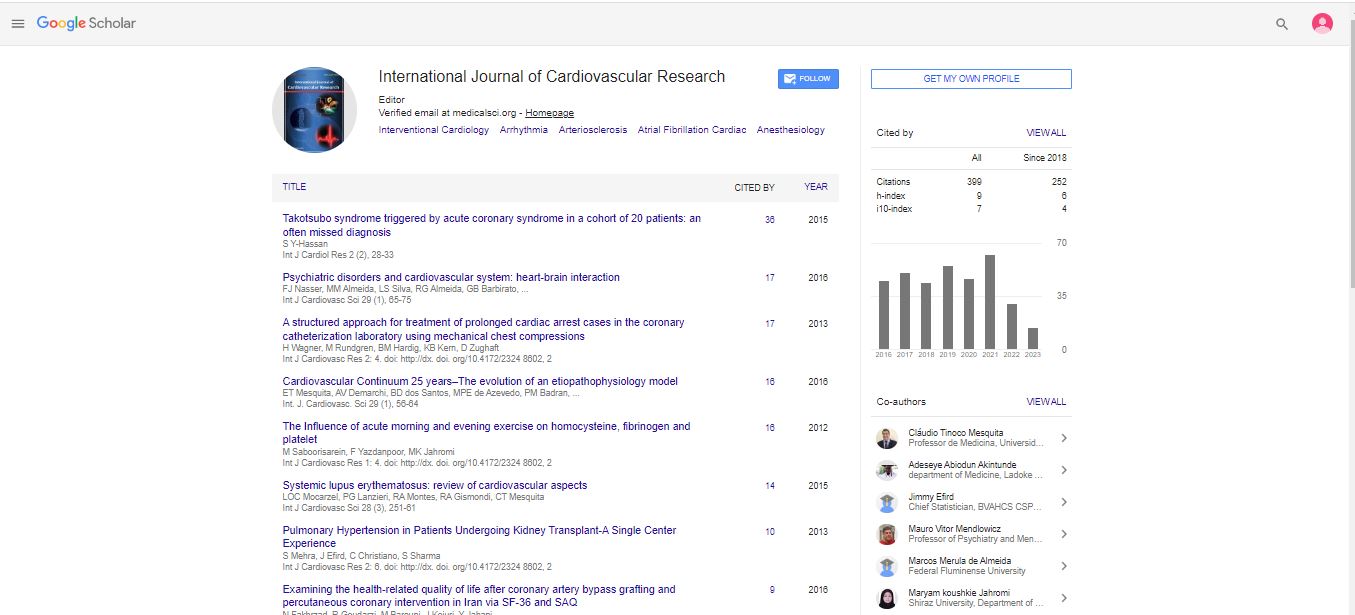Perspective, Int J Cardiol Res Vol: 13 Issue: 1
Muscular Dystrophy: Genetic Basis, Disease Progression, and Therapeutic Targets
Mireya Flouds*
1Department of Integrative Biology and Physiology, University of Minnesota Medical School, Minneapolis, United States of America
*Corresponding Author: Mireya Flouds,
Department of Integrative Biology and
Physiology, University of Minnesota Medical School, Minneapolis, United States of
America
E-mail: flouds.mir@umn.edu
Received date: 29 January, 2024, Manuscript No. ICRJ-24-134235;
Editor assigned date: 31 January, 2024, PreQC No. ICRJ-24-134235 (PQ);
Reviewed date: 14 February, 2024, QC No. ICRJ-24-134235;
Revised date: 21 February, 2024, Manuscript No. ICRJ-24-134235 (R);
Published date: 28 February, 2024, DOI: 10.4172/2324-8602.1000545.
Citation: Flouds M (2024) Muscular Dystrophy: Genetic Basis, Disease Progression, and Therapeutic Targets. Int J Cardiol Res 13:1.
Description
Muscular dystrophy stands as a formidable adversary within the field of neuromuscular disorders, captivating the attention of clinicians, researchers, and patients alike. Characterized by progressive muscle weakness and degeneration, this heterogeneous group of genetic conditions encompasses a myriad of subtypes, each with its unique clinical manifestations and underlying pathophysiology. In this scientific exposition, we embark on a journey through the labyrinthine corridors of muscular dystrophy, delving into its etiology, clinical features, diagnostic modalities, and therapeutic avenues. At the heart of muscular dystrophy lies a complex interplay of genetic aberrations, molecular perturbations, and immunological dysregulation. The archetypal form of muscular dystrophy, Duchenne Muscular Dystrophy (DMD), stems from mutations in the DMD gene, which encodes dystrophin, a crucial protein anchoring the muscle fiber cytoskeleton to the extracellular matrix. Loss of dystrophin function precipitates sarcolemmal instability, aberrant calcium influx, and downstream muscle fiber necrosis, culminating in progressive muscle wasting and weakness.
Beyond DMD, a panoply of dystrophinopathies and nondystrophinopathies, including Becker Muscular Dystrophy (BMD), Limb-Girdle Muscular Dystrophy (LGMD), and Myotonic Dystrophy (DM), elucidate the diverse genetic underpinnings of muscular dystrophy. Disruptions in sarcolemmal integrity, mitochondrial dysfunction, and aberrant immune responses contribute to the pathogenesis of these disorders, perpetuating a vicious cycle of muscle damage and regeneration. The clinical spectrum of muscular dystrophy spans a continuum of severity, encompassing asymptomatic carriers, mildly affected individuals, and severely debilitated patients confined to wheelchairs. DMD, the most prevalent and devastating form of muscular dystrophy, typically manifests in early childhood with delayed motor milestones, proximal muscle weakness, and calf hypertrophy. Contrastingly, BMD manifests later in life with a milder phenotype, characterized by variable degrees of muscle weakness and cardiac involvement.
LGMD encompasses a heterogeneous group of disorders characterized by progressive weakness and wasting of the pelvic and shoulder girdle muscles. Myotonic dystrophy, the most common form of adult-onset muscular dystrophy, manifests with myotonia, muscle weakness, and multisystemic involvement, including cardiac conduction abnormalities and cognitive impairment. The diagnosis of muscular dystrophy hinges upon a judicious integration of clinical evaluation, genetic testing, and ancillary investigations. Serum Creatine Kinase (CK) levels serve as a sensitive marker of muscle damage, with markedly elevated levels observed in most forms of muscular dystrophy. Electromyography (EMG) and muscle biopsy facilitate the delineation of myopathic changes, dystrophic features, and fiber type grouping, guiding diagnostic algorithms and prognostic assessments. Advancements in genetic sequencing technologies have revolutionized the diagnostic field of muscular dystrophy, enabling comprehensive molecular profiling and genotype-phenotype correlations. Next-Generation Sequencing (NGS) platforms, including Whole-Exome Sequencing (WES) and Whole-Genome Sequencing (WGS), facilitate the identification of causative mutations in a timely and cost-effective manner, empowering clinicians with actionable insights into disease pathogenesis and prognosis.
Therapeutic strategies for muscular dystrophy encompass a multifaceted approach aimed at ameliorating symptoms, preserving muscle function, and mitigating disease progression. Pharmacological interventions, including corticosteroids, exon-skipping therapies, and myostatin inhibitors, have demonstrated efficacy in delaying disease progression and improving ambulatory function in select subtypes of muscular dystrophy. Emerging modalities, such as gene therapy, stem cell transplantation, and CRISPR-Cas9 genome editing, hold promise as transformative interventions capable of correcting underlying genetic defects and restoring dystrophin expression. Regenerative medicine approaches, leveraging the regenerative capacity of muscle progenitor cells and induced Pluripotent Stem Cells (iPSCs), offer potential avenues for muscle regeneration and functional recovery.
Conclusion
Muscular dystrophy represents a multifaceted clinical entity characterized by genetic heterogeneity, phenotypic variability, and progressive muscle degeneration. As we navigate the intricate tapestry of muscular dystrophy, we are reminded of the imperative for interdisciplinary collaboration, translational research, and patientcentered care. Through concerted efforts spanning basic science research, clinical trials, and therapeutic innovation, we endeavor to unravel the mysteries of muscular dystrophy, offering hope to countless individuals afflicted by this debilitating disorder.
 Spanish
Spanish  Chinese
Chinese  Russian
Russian  German
German  French
French  Japanese
Japanese  Portuguese
Portuguese  Hindi
Hindi 



